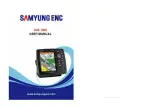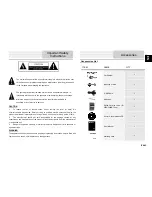
Installation and Operation Manual
9
1-1 Summary
AIS is a spearhead equipment to provide
voyage information such as ship’s position,
course, speed, etc. real time. This is to
protect the marine collision of ships,
obligations, IMO promotes. AIS induction
makes it possible to recognize the existence
of other ships & progress status, even if
radar cannot recognize ships around. Under
the poor field of visions, this can discern ship
name, course, speed, which can make safety
managements
such
as
ship
collision
protection, broad area control, search &
rescue, etc, more efficiently. AIS is using VHF
frequency.
In
1997,
International
Telecommunication
Union
World
Radio
communication Conference specified two
VHF frequencies (161.975 MHz - 87B channel
& 162.025 MHz - 88B channel) for AIS.
AIS-50N has high efficiency AIS Class B. It
provides plotter functions, needed in voyage.
Some functions can be used with
establishment of option devices and sensors
only.
AIS-50N can be connected to outer devices,
which have NMEA0183 or NMEA 2000. It can
display relevant information.
ex.)
• Navtex
• DSC VHF radiotelegraph
• Auto Navigation equipment
1-2 AIS Technology Summary
Communication methods of AIS are simplex,
semi-duplex, or duplex operation of TDMA
(Time Division Multiple Access). Allowance of
occupied bandwidth is within 25
㎑
. These are
classified into A Class & B Class transceivers,
equipped on vessels, according to uses.
►
A Class transceiver
:
Mandatory installed
in international passenger ships & ocean-
going ships over 300ton. Ship positions
should be reported on voyage.
►
B Class transceiver
:
Mainly installed in
small ships of length under 65 feet.
4 data information, used in AIS are as
followings.
►
Safety Related Message :
This is
according to requirement of message,
includes voyage information or weather
warning.
►
Static Information :
IMO number, call
sign & vessel name, length & width of
vessel, vessel type. Renewal of antenna
positions (division of vessel prow, stern &
left light sides) of GPS is done every
6 minutes or when data are revised, or
there is a demand.
►
Dynamic Information :
Accurate mark of
ship position, overall status, Coordinated
Universal Time (UTC), course, speed,
heading, voyage status, yaw angle &
sensor information. These are renewed by
interval of following table, according to
change of speed & direction.
Voyage Related Information
:
Draft,
risk cargo, destination & ETA, route plan &
boarding persons. Renewal is done every 6
minutes or when data are revised, or there
is a demand.
1 Introduction
Installation and Operation Manual
10
Intervals of Information renewal are shown by table, according to ship status, classified by two
Classes of AIS.
Ship status (A Class)
Interval
Under speed 3 knots, in anchorage or moorage
3min.
Over speed 3 knots, in anchorage or moorage
10sec.
Under 14 knots in voyage
10sec.
Under 14 knots in changing courses in voyage
3
⅓
sec.
Over 14 knots under 23 knots in voyage
6sec.
Over 14 knots under 23 knots in changing courses in voyage
2sec.
Over 23 knots in voyage
2sec.
Over 23 knots in changing courses in voyage
2sec.
Ship status (B Class)
Interval
Under 2 knots in voyage
3min.
Over 2 knots in voyage
30sec.
General Overall contents, explained above, can be summarized as below table.
Data
A Class
B Class
Static Information of radio station
- MMSI
- vessel name
- vessel type
- call sign
- IMO number
- antenna position
Voyage Related Information
- draft
- boarding persons
- risk cargo
- destination & ETA
Dynamic Information of radio station
- Universal Time Coordinated. (UTC)
- ship position
- course(COG)
- speed(SOG)
- heading
- turn rate
- voyage status
- ship status
Safety Related Message
- alarm
- safety






































